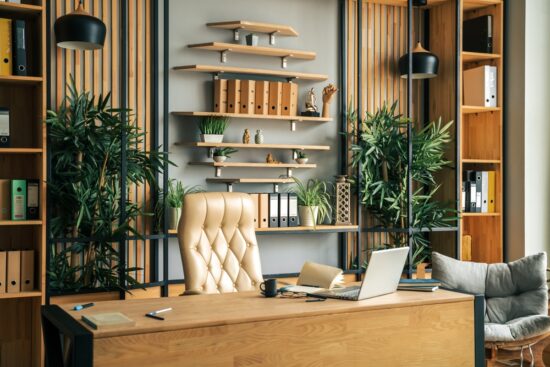
When it comes to designing a small office, the key is to make every square foot count. Even with limited space, you can create a functional, stylish, and efficient workspace that leaves a big impression. Here are some creative design tips to maximize your small office space while maintaining both form and function.
Embrace Multi-Functional Furniture
Investing in furniture that serves multiple purposes can save valuable space. Consider a desk with built-in storage or a sofa that doubles as a guest seating area. Foldable and modular furniture is also a great option for small offices, as it can be rearranged or stored away to suit different needs.
Optimize Vertical Space
When floor space is tight, look to the walls. Vertical storage solutions like floating shelves, wall-mounted cabinets, or pegboards can keep your workspace organized without cluttering your desk. Tall bookcases and storage units also draw the eye upward, making the space feel larger.
Choose a Light and Airy Color Palette
Lighter colors, such as whites, pastels, and neutrals, can make a small office feel more open and spacious. To add personality, incorporate pops of color through accessories like cushions, artwork, or a feature wall. Mirrors can also help reflect light and create the illusion of a larger space.
Prioritize Smart Lighting
Good lighting is crucial in small spaces. Natural light is ideal, so position your desk near a window if possible. For artificial lighting, opt for fixtures that don’t take up valuable desk or floor space, such as wall sconces or pendant lights. Adjustable lamps can provide focused lighting for tasks while adding a modern touch to your office.
Keep Clutter to a Minimum
Clutter can quickly overwhelm a small office, so it’s essential to adopt smart organization systems. Use labeled bins, stackable trays, and cable management solutions to keep everything in its place. Implement a minimalist approach by keeping only essential items within reach and storing less-used items out of sight.
Use Glass and Transparent Elements
Glass or acrylic furniture, such as desks and chairs, creates a sense of openness because it doesn’t visually block the space. Transparent partitions can also define different areas of your office without making it feel confined.
Maximize Corners
Often overlooked, corners can be transformed into functional areas. A corner desk or a compact shelving unit can utilize these spaces effectively. Alternatively, a cozy corner nook with a comfortable chair and small table can serve as a breakout area for brainstorming or relaxing.
Incorporate Greenery
Adding plants to your office brings a touch of nature and improves air quality. Choose compact or hanging plants that don’t take up much space. Vertical gardens or wall-mounted planters can add greenery without encroaching on your workspace.
Focus on Flexibility
Design your office with flexibility in mind to adapt to changing needs. For example, a folding desk can be stowed away to create more room for other activities, or movable partitions can reconfigure the layout as required. This adaptability ensures your small office remains functional and efficient.
Add Personal Touches
Even in a small office, it’s important to include elements that reflect your personality and brand. Display artwork, photos, or inspirational quotes that resonate with you. Personal touches make the space feel welcoming and uniquely yours without sacrificing professionalism.
Work with Experts
If designing a small office feels overwhelming, consider consulting professionals who specialize in creating efficient and stylish workspaces. Sensyst – The Business Interiors Group has extensive experience transforming compact spaces into highly functional and aesthetically pleasing offices. Their tailored solutions ensure every inch of your space is utilized effectively.
Conclusion
A small office doesn’t have to mean limited possibilities. By embracing smart design choices and creative solutions, you can create a workspace that is both functional and stylish. Whether it’s through multi-functional furniture, clever storage, or a light and airy design, the right strategies can help you make a big impact in even the smallest of spaces.

